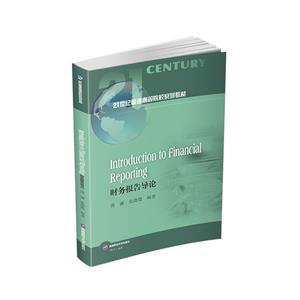Introduction to Finan Reporting(財務報告導論) 版權信息
- ISBN:9787550450356
- 條形碼:9787550450356 ; 978-7-5504-5035-6
- 裝幀:一般膠版紙
- 冊數:暫無
- 重量:暫無
- 所屬分類:>>
Introduction to Finan Reporting(財務報告導論) 本書特色
本教材遵循“十四五”規劃期間教育部對高校本科教材建設的總體指導方針,堅持以習近平新時代中國特色社會主義思想為指導,落實《全國大中小學教材建設規劃(2019-2022年)》和《普通高等學校教材管理辦法》,力求滿足普及化階段高等教育人才培養的需要。本教材是以國際會計準則(IAS)為基礎,由淺入深講解編制個體經營者、股份公司財務報表的全英文教材。本教材英文專業術語準確規范,報告編制方法反映了國際會計準則的*新變化;建立了財務報告的基本體系,涵蓋了財務會計的基礎內容及報表編制的核心內容。本教材按照 50~70課內學時,課內、外學時比為1∶1設計教學與習題內容;在闡述會計理論與實務方法時,既注重會計理論的深度與廣度,又強調會計實務的操作方法與應用。
Introduction to Finan Reporting(財務報告導論) 內容簡介
本書是全英文教材。本書是針對會計和非會計專業學生學習財務報告的入門導論。本書以講解個體經營者財務報告的編制為起點,在靠前財務報告概念框架指導下,通過對固定資產、無形資產、存貨和股本等相關靠前財務報告準則的學習,逐步幫助學生掌握上市公司利潤表、資產負債表、所有者權益變動表和現金流量表的編制技巧,并學會對財務報表的基本分析和解釋。本書適合高校學生及對相關領域有興趣學習的同學自學使用,有一定的普適性和出版價值。
Introduction to Finan Reporting(財務報告導論) 目錄
目錄Chapter 1 Statements of Profit or Loss: Sole Traders1.1 Introduction to the Statement of Profit or Loss1.2 Gross Profit and Net Profit1.3 Preparation of a Trading and Profit and Loss account1.4 Preparation of a Statement of Profit or LossExerciseChapter 2 Statement of Finan Position2.1 Contents of the Statement of Finan Position1. Assets2. Liabilities3. Capital2.2 Format of the Statement of Finan Position2.3 No Double Entry in Statements of Finan Position2.4 Drawing up a Statement of Finan PositionExerciseChapter 3 Statements of Profit or Loss and Statements of Finan Position: Further Considerations3.1 Returns Inwards and Return Outwards3.2 Carriage Inwards and Carriage Outwards3.3 The Second Year of a Business1. Adjustments Needed for Inventory2. Ledger Accounting for Inventory3. Other Expenses in the Trading AccountExerciseChapter 4 Inventory4.1 IAS 2 Inventories4.2 Cost of Goods Sold1. Recap2. Inventories Written off or Written down3. Inventory Destroyed or Stolen and Subject to an Insurance Claim4. Counting Inventory5. Accounting for Opening and Closing Inventories4.3 Measurement of Inventories1. Applying the Lower of Cost and NRV2. Determining the Cost of Inventory3. Different Valuations of Inventory4. Inventory Valuation and the Calculation of Profits4.4 Using Mark-up/Margin Percentages to Establish CostExerciseChapter 5 Irrecoverable Debts and Allowance for Receivables5.1 Irrecoverable Debts1. Introduction2. Writing off Irrecoverable Debts3. Irrecoverable Debts Written off and Subsequently Paid5.2 Allowance for Receivables1. Doubtful Debts2. Determining the Allowance for Receivables3. Allowance for Receivables: Ledger Accounting Entries4. Allowance for Receivables: Finan Statements5.3 Example: Irrecoverable Debts Written off and Allowance for Receivables CombinedExerciseChapter 6 Depreciation: Calculations and Double Entry6.1 What is Depreciation?1. Objective of Depreciation2. Definitions6.2 Causes of Depreciation1. Physical Depreciation2. Economic Factors3. Time4. Depletion6.3 Calculating Depreciation1. Methods of Depreciation2. Choice of Method3. Reviewing and Changing the Depreciation Method4. Reviewing and Changing Useful Life or Residual Value6.4 Accounting for DepreciationExerciseChapter 7 Accruals and Prepayments7.1 Introduction7.2 Accrued Expenses and Prepaid Expenses1. Accrued Expenses2. Prepaid Expenses3. Accruals and Prepayments in Finan Statements7.3 Accrual Principle and IncomeExerciseChapter 8 Provisions and Contingencies8.1 Provisions1.Definition2.Accounting for Provisions3.Measuring the Amount of Provisions8.2 Contingent Liabilities and Contingent Assets1.Contingent Liabilities2.Contingent Assets3.Decision Tree of IAS 378.3 Disclosure in Finan StatementsExerciseChapter 9 Tangible Non-current Assets9.1 Capital vs Revenue Expenditure1. The Distinction between Capital and Revenue Expenditure2. Capital Income and Revenue Income9.2 IAS 16 Property, Plant and Equipment1. Definition of Property, Plant and Equipment2. Measurement of Property, Plant and Equipment9.3 Revaluation of Non-current Assets1. Accounting Treatment for Revaluation Gain and Losses2. A Worked Example9.4 Non-current Assets Disposals1. The Principles behind Calculating the Profit or Loss on Disposal2. Accounting Treatment for Asset Disposals3. Accounting for Disposals of Non-Current Assets Given in Part Exchange9.5 Disclosure in Finan StatementsExerciseChapter 10 Intangible Non-current Assets10.1 Intangible Assets1. Intangible Assets Defined2. Accounting Treatment10.2 Research and Development1. Definition of Research and Development2. Recognition of Research and Development3. Accounting Treatment of Research and Development10.3 Disclosure in Finan StatementsExerciseChapter 11 Introduction to Company Accounting11.1 The Nature of a Limited Company1. Separate Legal Entity and Limited Liabilities2. The Classes of Limited Companies3. The Capital of Limited Liability Companies11.2 Equity: Share Capital1. Ordinary Shares and Preference Shares2. Accounting for Share Capital11.3 Equity: Retained Earnings and Other Reserves1. Retained Earnings2. Share Premium3. Other Reserves4. Dividends11.4 Bonus and Rights Issue1. Bonus Issue2. Rights Issue11.5 Ledger Accounts of a Limited Liability Company1. Taxation2. Loan Stock3. Finance CostsExerciseChapter 12 Preparation of Finan Statements for Companies12.1 IAS 1: Presentation of Finan Statements12.2 The Statement of Finan Position12.3 The Statement of Profit or Loss and Other Comprehensive Income1. Other Comprehensive Income and Basic Requirements2. Cost of Sales, Distribution Costs and Administrative Expenses3. Other Income12.4 The Statement of Changes in Equity12.5 Notes to the Finan Statements12.6 A Worked ExampleExerciseChapter 13 Statement of Cash Flows13.1 Introduction to the Statement of Cash Flows1. Purpose of the Statement of Cash Flows2. Cash versus Profit13.2 IAS 7 – Statement of Cash Flows1. Objective and Scope2. Definitions13.3 Presentation of the Statement of Cash Flows1. Cash Flows from Operating Activities2. Cash Flows from Investing Activities3. Cash Flows from Financing Activities4. Cash and Cash Equivalents13.4 An Example: Preparing a Statement of Cash FlowsExerciseChapter 14 An Introduction to Finan Analysis14.1 Basics of Finan Analysis1. Users of the Ratios2. Overview of Finan Statements14.2 Ratio Analysis1. Profitability Ratios2. Liquidity Ratios3. Gearing/Leverage Ratios4. Efficiency Ratios5. Investment Ratios14.3 Interpretating Finan Information1. A Worked Example2. Limitations of Ratio AnalysisExerciseAnswersChapter 1Chapter 2ChapterChapter 4Chapter 5Chapter 6Chapter 7Chapter 8Chapter 9Chapter 10Chapter 11Chapter 12Chapter 13Chapter 14
展開全部
Introduction to Finan Reporting(財務報告導論) 作者簡介
薄瀾,遼寧大學新華靠前商學院副教授、碩士生導師、英國德蒙福特大學訪問學者。主講課程:《初級財務會計》、《中級財務會計》與《會計實務》。張微微,遼寧大學新華靠前商學院講師、碩士生導師。教學經驗豐富,主講課程:《初級財務會計》與《會計學基礎》。
















